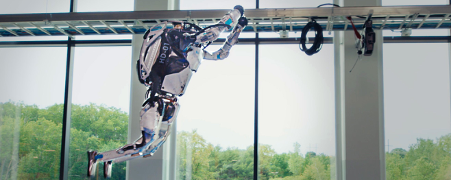
By training Atlas to maneuver its way through complex parkour courses, Boston Dynamics engineers develop new movements inspired by human behaviors and push the humanoid robot to its limits.
For the first time today, both Atlas robots have completed the complex obstacle course flawlessly. Or, almost flawlessly.
The first of the two robots ran up a series of banked plywood panels, broad jumped a gap, and ran up and down stairs in the course set up on the second floor of the Boston Dynamics headquarters. The second robot leapt onto a balance beam and followed the same steps in reverse, and then the first robot vaulted over the beam. Both landed two perfectly synchronized backflips, and the video team has captured every move.
And yet, the robotics engineers who have been working on this routine for months barely take time to celebrate. Moments after the cameras cut they’re huddled together, making changes before the next take. Although this most recent attempt was nearly perfect, it was not precisely perfect, not quite. After the robots completed their backflips, one was supposed to pump its arm like a big-league pitcher after a game-ending strikeout – a move that the Atlas team calls the “Cha-Ching.”
The robot did pump its arm, but it also stumbled a bit on this simple move. It was just the slightest stutter step, something most people watching the video would never notice. But the Atlas team notices every detail and they want to get it right.
“We hadn’t run that behavior after the backflip before today, so that was really an experiment,” says Scott Kuindersma, the Atlas team lead at Boston Dynamics. “If you watch the video closely, it looks a little awkward. We’re going to swap in a behavior we’ve tested before so we have some confidence it will work.”
The perfectionism on display here is admirable, and one gets the sense that this sort of attention to detail is what has produced robots that are capable of completing such a futuristic, impossible-seeming routine. But it also raises a question that at first seems surprising, but then seems obvious: Why does it matter?
Why does it matter if Atlas stutters when it pumps its fist? Why does it matter if it pumps its fist at all, for that matter? And while we’re asking questions, what exactly is the use of running the robots through an obstacle course? Why the banked plywood panels, why the vault, why the backflips?
In short: Why parkour?